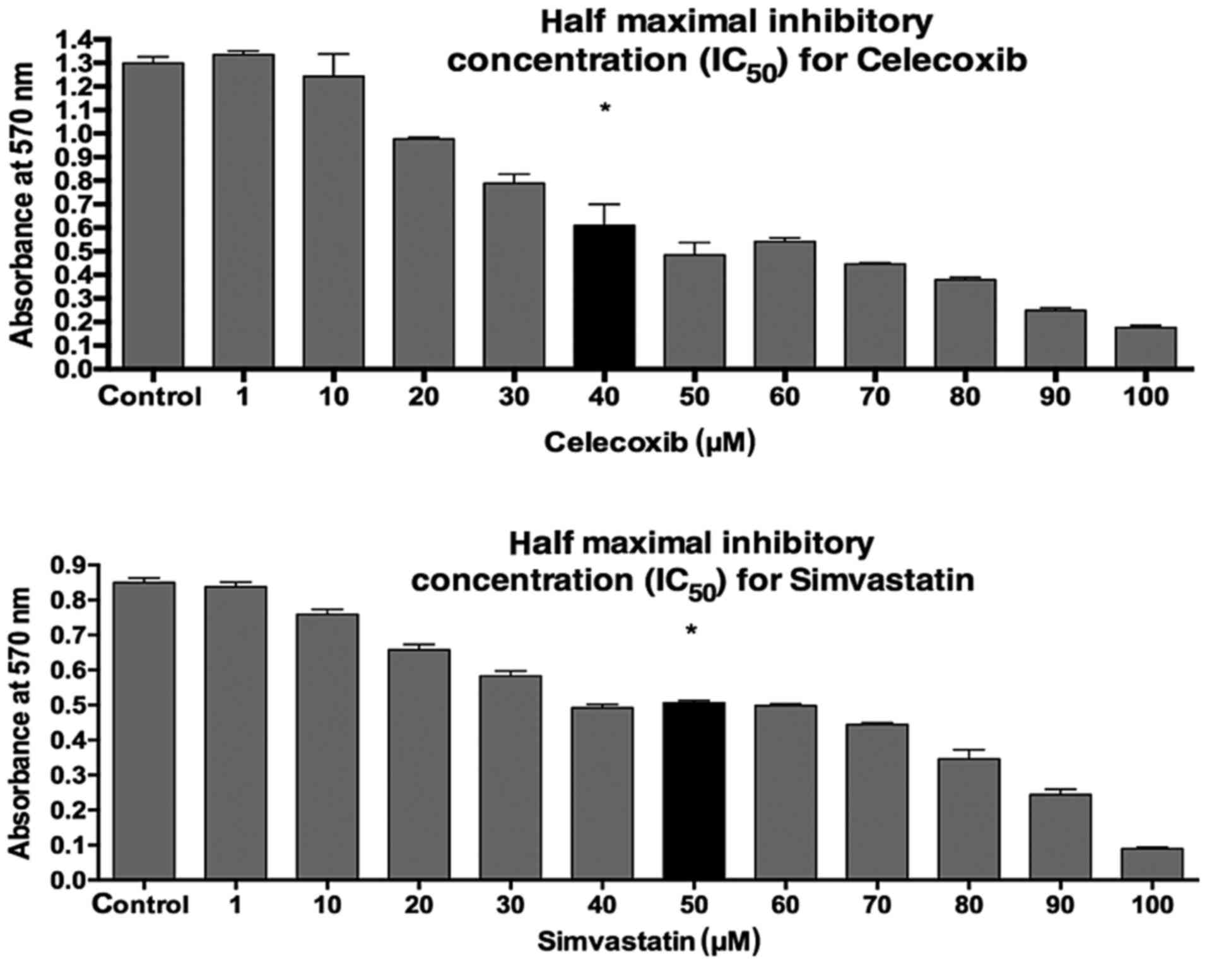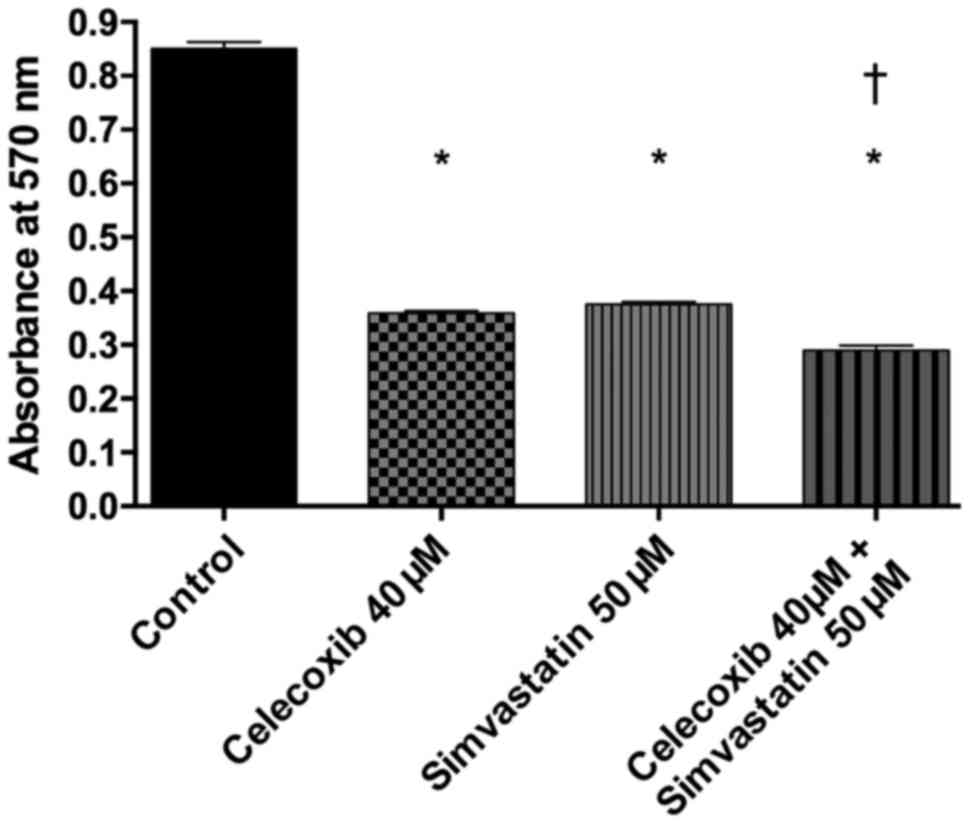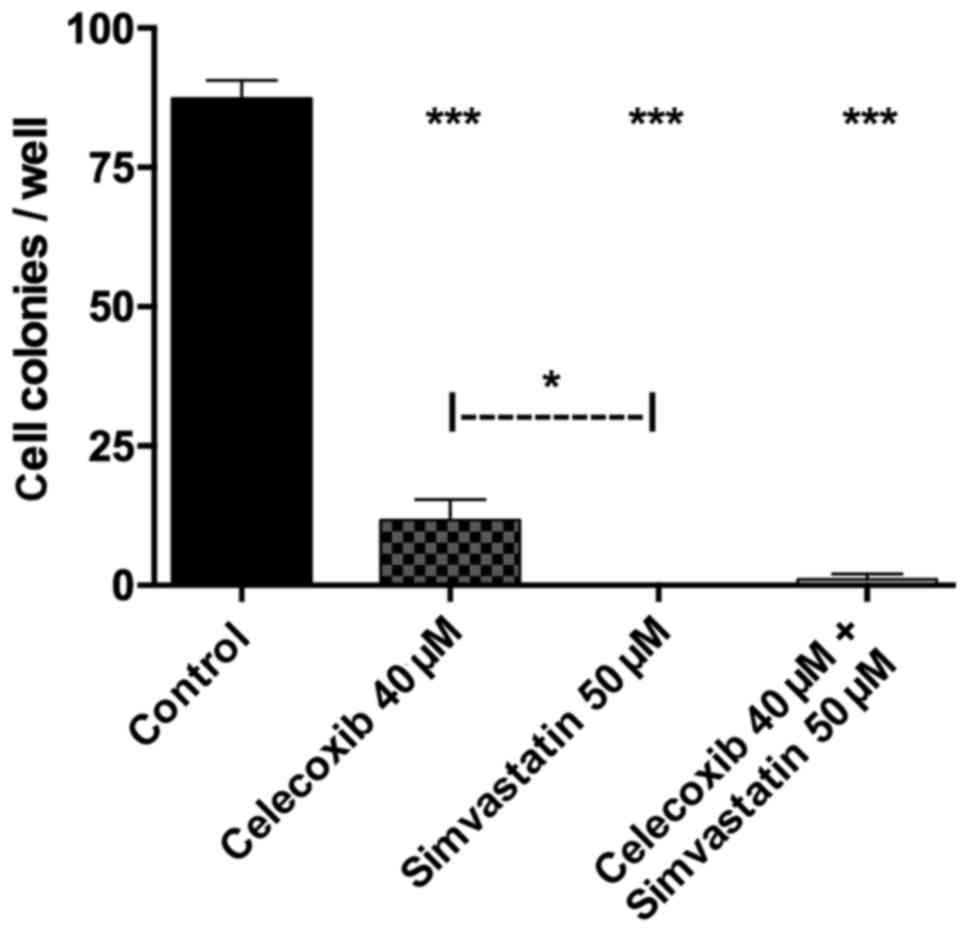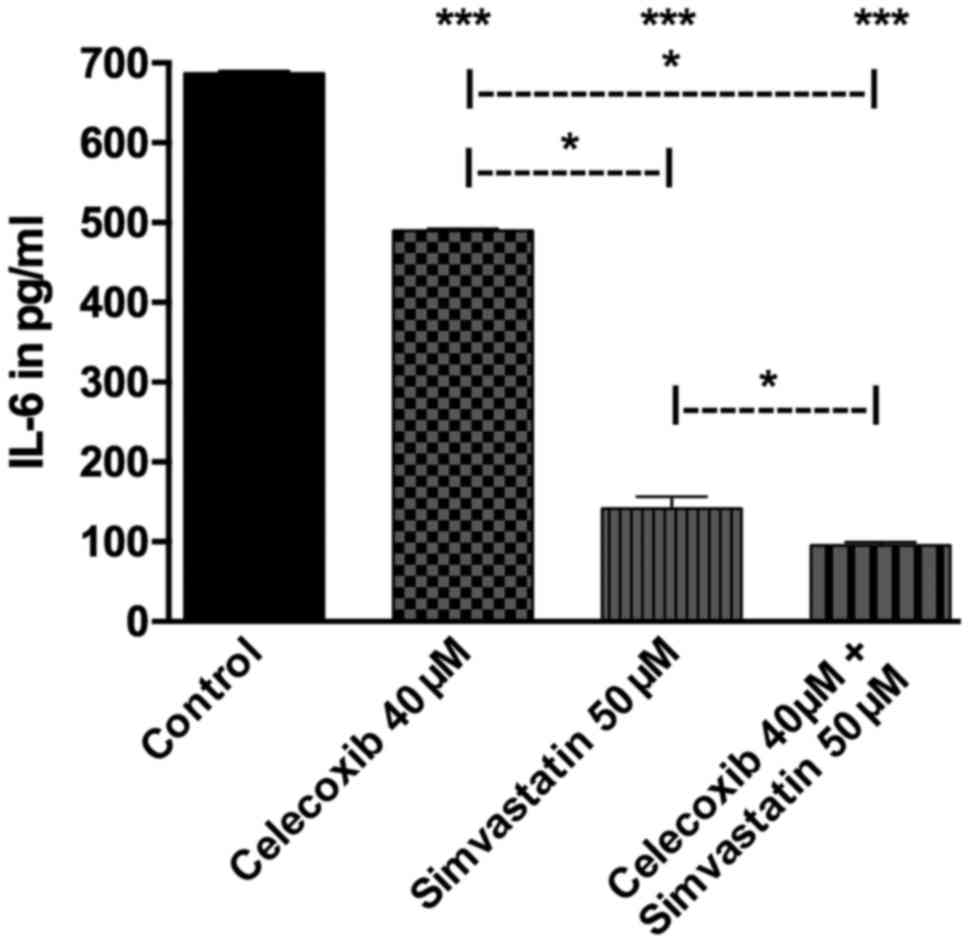Additive antitumor effects of celecoxib and simvastatin on head and neck squamous cell carcinoma in vitro
- Authors:
- Thomas Gehrke
- Agmal Scherzad
- Stephan Hackenberg
- Pascal Ickrath
- Philipp Schendzielorz
- Rudolf Hagen
- Norbert Kleinsasser
-
Affiliations: Department of Otorhinolaryngology, Head and Neck Surgery, University Hospital Wuerzburg, D-97080 Wuerzburg, Germany - Published online on: July 10, 2017 https://doi.org/10.3892/ijo.2017.4071
- Pages: 931-938
This article is mentioned in:
Abstract
 |
 |
 |
 |
 |
 |
 |
 |
 |
|
Miller KD, Siegel RL, Lin CC, Mariotto AB, Kramer JL, Rowland JH, Stein KD, Alteri R and Jemal A: Cancer treatment and survivorship statistics, 2016. CA Cancer J Clin. 66:271–289. 2016. View Article : Google Scholar : PubMed/NCBI | |
|
Siegel RL, Miller KD and Jemal A: Cancer statistics, 2016. CA Cancer J Clin. 66:7–30. 2016. View Article : Google Scholar : PubMed/NCBI | |
|
Herrero R, Castellsagué X, Pawlita M, Lissowska J, Kee F, Balaram P, Rajkumar T, Sridhar H, Rose B, Pintos J, et al IARC Multicenter Oral Cancer Study Group: Human papillomavirus and oral cancer: The International Agency for Research on Cancer multicenter study. J Natl Cancer Inst. 95:1772–1783. 2003. View Article : Google Scholar : PubMed/NCBI | |
|
Xiao H and Yang CS: Combination regimen with statins and NSAIDs: A promising strategy for cancer chemoprevention. Int J Cancer. 123:983–990. 2008. View Article : Google Scholar : PubMed/NCBI | |
|
Prasanna P, Thibault A, Liu L and Samid D: Lipid metabolism as a target for brain cancer therapy: Synergistic activity of lovastatin and sodium phenylacetate against human glioma cells. J Neurochem. 66:710–716. 1996. View Article : Google Scholar : PubMed/NCBI | |
|
Xia Z, Tan MM, Wong WW, Dimitroulakos J, Minden MD and Penn LZ: Blocking protein geranylgeranylation is essential for lovastatin-induced apoptosis of human acute myeloid leukemia cells. Leukemia. 15:1398–1407. 2001. View Article : Google Scholar : PubMed/NCBI | |
|
Zhuang L, Kim J, Adam RM, Solomon KR and Freeman MR: Cholesterol targeting alters lipid raft composition and cell survival in prostate cancer cells and xenografts. J Clin Invest. 115:959–968. 2005. View Article : Google Scholar : PubMed/NCBI | |
|
Blais L, Desgagné A and LeLorier J: 3-Hydroxy-3-methylglutaryl coenzyme A reductase inhibitors and the risk of cancer: A nested case-control study. Arch Intern Med. 160:2363–2368. 2000. View Article : Google Scholar : PubMed/NCBI | |
|
Graaf MR, Beiderbeck AB, Egberts AC, Richel DJ and Guchelaar HJ: The risk of cancer in users of statins. J Clin Oncol. 22:2388–2394. 2004. View Article : Google Scholar : PubMed/NCBI | |
|
Friis S, Poulsen AH, Johnsen SP, McLaughlin JK, Fryzek JP, Dalton SO, Sørensen HT and Olsen JH: Cancer risk among statin users: A population-based cohort study. Int J Cancer. 114:643–647. 2005. View Article : Google Scholar | |
|
Olsen JH, Johansen C, Sørensen HT, McLaughlin JK, Mellemkjaer L, Steffensen FH and Fraumeni JF Jr: Lipid-lowering medication and risk of cancer. J Clin Epidemiol. 52:167–169. 1999. View Article : Google Scholar : PubMed/NCBI | |
|
Kaye JA and Jick H: Statin use and cancer risk in the General Practice research Database. Br J Cancer. 90:635–637. 2004. View Article : Google Scholar : PubMed/NCBI | |
|
Poynter JN, Gruber SB, Higgins PD, Almog R, Bonner JD, Rennert HS, Low M, Greenson JK and Rennert G: Statins and the risk of colorectal cancer. N Engl J Med. 352:2184–2192. 2005. View Article : Google Scholar : PubMed/NCBI | |
|
Khurana V, Bejjanki HR, Caldito G and Owens MW: Statins reduce the risk of lung cancer in humans: A large case-control study of US veterans. Chest. 131:1282–1288. 2007. View Article : Google Scholar : PubMed/NCBI | |
|
Farwell WR, Scranton RE, Lawler EV, Lew RA, Brophy MT, Fiore LD and Gaziano JM: The association between statins and cancer incidence in a veterans population. J Natl Cancer Inst. 100:134–139. 2008. View Article : Google Scholar : PubMed/NCBI | |
|
Khurana V, Caldito G and Ankem M: Statins might reduce risk of renal cell carcinoma in humans: Case-control study of 500,000 veterans. Urology. 71:118–122. 2008. View Article : Google Scholar : PubMed/NCBI | |
|
Kulp SK, Yang YT, Hung CC, Chen KF, Lai JP, Tseng PH, Fowble JW, Ward PJ and Chen CS: 3-phosphoinositide-dependent protein kinase-1/Akt signaling represents a major cyclooxygenase-2-independent target for celecoxib in prostate cancer cells. Cancer Res. 64:1444–1451. 2004. View Article : Google Scholar : PubMed/NCBI | |
|
Johnson AJ, Hsu AL, Lin HP, Song X and Chen CS: The cyclooxygenase-2 inhibitor celecoxib perturbs intracellular calcium by inhibiting endoplasmic reticulum Ca2+-ATPases: A plausible link with its anti-tumour effect and cardiovascular risks. Biochem J. 366:831–837. 2002. View Article : Google Scholar : PubMed/NCBI | |
|
Luciani MG, Campregher C and Gasche C: Aspirin blocks proliferation in colon cells by inducing a G1 arrest and apoptosis through activation of the checkpoint kinase ATM. Carcinogenesis. 28:2207–2217. 2007. View Article : Google Scholar : PubMed/NCBI | |
|
Thun MJ, Henley SJ and Patrono C: Nonsteroidal anti-inflammatory drugs as anticancer agents: Mechanistic, pharmacologic, and clinical issues. J Natl Cancer Inst. 94:252–266. 2002. View Article : Google Scholar : PubMed/NCBI | |
|
Giardiello FM, Hamilton SR, Krush AJ, Piantadosi S, Hylind LM, Celano P, Booker SV, Robinson CR and Offerhaus GJ: Treatment of colonic and rectal adenomas with sulindac in familial adenomatous polyposis. N Engl J Med. 328:1313–1316. 1993. View Article : Google Scholar : PubMed/NCBI | |
|
Labayle D, Fischer D, Vielh P, Drouhin F, Pariente A, Bories C, Duhamel O, Trousset M and Attali P: Sulindac causes regression of rectal polyps in familial adenomatous polyposis. Gastroenterology. 101:635–639. 1991. View Article : Google Scholar : PubMed/NCBI | |
|
Nugent KP, Farmer KC, Spigelman AD, Williams CB and Phillips RK: Randomized controlled trial of the effect of sulindac on duodenal and rectal polyposis and cell proliferation in patients with familial adenomatous polyposis. Br J Surg. 80:1618–1619. 1993. View Article : Google Scholar : PubMed/NCBI | |
|
Steinbach G, Lynch PM, Phillips RK, Wallace MH, Hawk E, Gordon GB, Wakabayashi N, Saunders B, Shen Y, Fujimura T, et al: The effect of celecoxib, a cyclooxygenase-2 inhibitor, in familial adenomatous polyposis. N Engl J Med. 342:1946–1952. 2000. View Article : Google Scholar : PubMed/NCBI | |
|
Bertagnolli MM, Eagle CJ, Zauber AG, Redston M, Solomon SD, Kim K, Tang J, Rosenstein RB, Wittes J, Corle D, et al APC Study Investigators: Celecoxib for the prevention of sporadic colorectal adenomas. N Engl J Med. 355:873–884. 2006. View Article : Google Scholar : PubMed/NCBI | |
|
Arber N, Eagle CJ, Spicak J, Rácz I, Dite P, Hajer J, Zavoral M, Lechuga MJ, Gerletti P, Tang J, et al PreSAP Trial Investigators: Celecoxib for the prevention of colorectal adenomatous polyps. N Engl J Med. 355:885–895. 2006. View Article : Google Scholar : PubMed/NCBI | |
|
Bresalier RS, Sandler RS, Quan H, Bolognese JA, Oxenius B, Horgan K, Lines C, Riddell R, Morton D, Lanas A, et al Adenomatous Polyp Prevention on Vioxx (APPROVe) Trial Investigators: Cardiovascular events associated with rofecoxib in a colorectal adenoma chemoprevention trial. N Engl J Med. 352:1092–1102. 2005. View Article : Google Scholar : PubMed/NCBI | |
|
Kerr DJ, Dunn JA, Langman MJ, Smith JL, Midgley RS, Stanley A, Stokes JC, Julier P, Iveson C, Duvvuri R, et al VICTOR Trial Group: Rofecoxib and cardiovascular adverse events in adjuvant treatment of colorectal cancer. N Engl J Med. 357:360–369. 2007. View Article : Google Scholar : PubMed/NCBI | |
|
Solomon SD, McMurray JJ, Pfeffer MA, Wittes J, Fowler R, Finn P, Anderson WF, Zauber A, Hawk E and Bertagnolli M; Adenoma Prevention with Celecoxib (APC) Study Investigators: Cardiovascular risk associated with celecoxib in a clinical trial for colorectal adenoma prevention. N Engl J Med. 352:1071–1080. 2005. View Article : Google Scholar : PubMed/NCBI | |
|
Swamy MV, Cooma I, Reddy BS and Rao CV: Lamin B, caspase-3 activity, and apoptosis induction by a combination of HMG-CoA reductase inhibitor and COX-2 inhibitors: A novel approach in developing effective chemopreventive regimens. Int J Oncol. 20:753–759. 2002.PubMed/NCBI | |
|
Agarwal B, Rao CV, Bhendwal S, Ramey WR, Shirin H, Reddy BS and Holt PR: Lovastatin augments sulindac-induced apoptosis in colon cancer cells and potentiates chemopreventive effects of sulindac. Gastroenterology. 117:838–847. 1999. View Article : Google Scholar : PubMed/NCBI | |
|
Zheng X, Cui XX, Avila GE, Huang MT, Liu Y, Patel J, Kong AN, Paulino R, Shih WJ, Lin Y, et al: Atorvastatin and celecoxib inhibit prostate PC-3 tumors in immunodeficient mice. Clin Cancer Res. 13:5480–5487. 2007. View Article : Google Scholar : PubMed/NCBI | |
|
Hoffmeister M, Chang-Claude J and Brenner H: Individual and joint use of statins and low-dose aspirin and risk of colorectal cancer: A population-based case-control study. Int J Cancer. 121:1325–1330. 2007. View Article : Google Scholar : PubMed/NCBI | |
|
Flick ED, Habel LA, Chan KA, Van Den Eeden SK, Quinn VP, Haque R, Orav EJ, Seeger JD, Sadler MC, Quesenberry CP Jr, et al: Statin use and risk of prostate cancer in the California Men's Health Study cohort. Cancer Epidemiol Biomarkers Prev. 16:2218–2225. 2007. View Article : Google Scholar : PubMed/NCBI | |
|
Taga T, Hibi M, Hirata Y, Yamasaki K, Yasukawa K, Matsuda T, Hirano T and Kishimoto T: Interleukin-6 triggers the association of its receptor with a possible signal transducer, gp130. Cell. 58:573–581. 1989. View Article : Google Scholar : PubMed/NCBI | |
|
He G, Dhar D, Nakagawa H, Font-Burgada J, Ogata H, Jiang Y, Shalapour S, Seki E, Yost SE, Jepsen K, et al: Identification of liver cancer progenitors whose malignant progression depends on autocrine IL-6 signaling. Cell. 155:384–396. 2013. View Article : Google Scholar : PubMed/NCBI | |
|
Trikha M, Corringham R, Klein B and Rossi JF: Targeted anti-interleukin-6 monoclonal antibody therapy for cancer: a review of the rationale and clinical evidence. Clin Cancer Res. 9:4653–4665. 2003.PubMed/NCBI | |
|
Zhang GJ and Adachi I: Serum interleukin-6 levels correlate to tumor progression and prognosis in metastatic breast carcinoma. Anticancer res. 19:1427–1432. 1999.PubMed/NCBI | |
|
Zabaleta J, Su LJ, Lin HY, Sierra RA, Hall MC, Sartor AO, Clark PE, Hu JJ and Ochoa AC: Cytokine genetic polymorphisms and prostate cancer aggressiveness. Carcinogenesis. 30:1358–1362. 2009. View Article : Google Scholar : PubMed/NCBI | |
|
Li A, Varney ML and Singh RK: Expression of interleukin 8 and its receptors in human colon carcinoma cells with different metastatic potentials. Clin Cancer res. 7:3298–3304. 2001.PubMed/NCBI | |
|
Ren Y, Poon RT, Tsui HT, Chen WH, Li Z, Lau C, Yu WC and Fan ST: Interleukin-8 serum levels in patients with hepatocellular carcinoma: correlations with clinicopathological features and prognosis. Clin Cancer res. 9:5996–6001. 2003.PubMed/NCBI | |
|
Mosmann T: Rapid colorimetric assay for cellular growth and survival: Application to proliferation and cytotoxicity assays. J Immunol Methods. 65:55–63. 1983. View Article : Google Scholar : PubMed/NCBI | |
|
Chou TC and Talalay P: Quantitative analysis of dose-effect relationships: The combined effects of multiple drugs or enzyme inhibitors. Adv Enzyme Regul. 22:27–55. 1984. View Article : Google Scholar : PubMed/NCBI | |
|
Chan GG, Tai BC, Liang S, Lim DT and Soo KC: Squamous cell carcinoma of the head and neck (HNSCC) - multi-modality treatment and impact on survival. Asian J Surg. 25:35–40. 2002. | |
|
Patil V, Joshi A, Noronha V, Deodhar J, Bhattacharjee A, Dhumal S, Chandrakanth MV, Karpe A, Talreja V, ChandRasekharan A, et al: Expectations and preferences for palliative chemotherapy in head and neck cancers patients. Oral Oncol. 63:10–15. 2016. View Article : Google Scholar : PubMed/NCBI | |
|
Xiao H, Zhang Q, Lin Y, Reddy BS and Yang CS: Combination of atorvastatin and celecoxib synergistically induces cell cycle arrest and apoptosis in colon cancer cells. Int J Cancer. 122:2115–2124. 2008. View Article : Google Scholar : PubMed/NCBI | |
|
Goldstein JL and Brown MS: Regulation of the mevalonate pathway. Nature. 343:425–430. 1990. View Article : Google Scholar : PubMed/NCBI | |
|
Ogunwobi OO and Beales IL: Statins inhibit proliferation and induce apoptosis in Barrett's esophageal adenocarcinoma cells. Am J Gastroenterol. 103:825–837. 2008. View Article : Google Scholar : PubMed/NCBI | |
|
Kundu N, Smyth MJ, Samsel L and Fulton AM: Cyclooxygenase inhibitors block cell growth, increase ceramide and inhibit cell cycle. Breast Cancer Res Treat. 76:57–64. 2002. View Article : Google Scholar : PubMed/NCBI | |
|
Kim SH, Song SH, Kim SG, Chun KS, Lim SY, Na HK, Kim JW, Surh YJ, Bang YJ and Song YS: Celecoxib induces apoptosis in cervical cancer cells independent of cyclooxygenase using NF-kappab as a possible target. J Cancer res Clin Oncol. 130:551–560. 2004. View Article : Google Scholar : PubMed/NCBI | |
|
Grösch S, Tegeder I, Niederberger E, Bräutigam L and Geisslinger G: COX-2 independent induction of cell cycle arrest and apoptosis in colon cancer cells by the selective COX-2 inhibitor celecoxib. FASEB J. 15:2742–2744. 2001.PubMed/NCBI | |
|
Kardosh A, Blumenthal M, Wang WJ, Chen TC and Schönthal AH: Differential effects of selective COX-2 inhibitors on cell cycle regulation and proliferation of glioblastoma cell lines. Cancer Biol Ther. 3:55–62. 2004. View Article : Google Scholar : PubMed/NCBI | |
|
Liu JD, Wang YJ, Chen CH, Yu CF, Chen LC, Lin JK, Liang YC, Lin SY and Ho YS: Molecular mechanisms of G0/G1 cell-cycle arrest and apoptosis induced by terfenadine in human cancer cells. Mol Carcinog. 37:39–50. 2003. View Article : Google Scholar : PubMed/NCBI | |
|
Berishaj M, Gao SP, Ahmed S, Leslie K, Al-Ahmadie H, Gerald WL, Bornmann W and Bromberg JF: Stat3 is tyrosine-phosphorylated through the interleukin-6/glycoprotein 130/Janus kinase pathway in breast cancer. Breast Cancer Res. 9:R322007. View Article : Google Scholar : PubMed/NCBI | |
|
Bollrath J, Phesse TJ, von Burstin VA, Putoczki T, Bennecke M, Bateman T, Nebelsiek T, Lundgren-May T, Canli O, Schwitalla S, et al: gp130-mediated Stat3 activation in enterocytes regulates cell survival and cell-cycle progression during colitis-associated tumorigenesis. Cancer Cell. 15:91–102. 2009. View Article : Google Scholar : PubMed/NCBI | |
|
Liu Y, Liu A, Li H, Li C and Lin J: Celecoxib inhibits interleukin-6/interleukin-6 receptor-induced JAK2/STAT3 phosphorylation in human hepatocellular carcinoma cells. Cancer Prev Res (Phila). 4:1296–1305. 2011. View Article : Google Scholar | |
|
Bianchi M, Broggini M, Balzarini P, Franchi S and Sacerdote P: Effects of nimesulide on pain and on synovial fluid concentrations of substance P, interleukin-6 and interleukin-8 in patients with knee osteoarthritis: Comparison with celecoxib. Int J Clin Pract. 61:1270–1277. 2007. View Article : Google Scholar : PubMed/NCBI | |
|
Yokota K, Miyazaki T, Hirano M, Akiyama Y and Mimura T: Simvastatin inhibits production of interleukin 6 (IL-6) and IL-8 and cell proliferation induced by tumor necrosis factor-alpha in fibroblast-like synoviocytes from patients with rheumatoid arthritis. J Rheumatol. 33:463–471. 2006.PubMed/NCBI | |
|
Yuan A, Yang PC, Yu CJ, Chen WJ, Lin FY, Kuo SH and Luh KT: Interleukin-8 messenger ribonucleic acid expression correlates with tumor progression, tumor angiogenesis, patient survival, and timing of relapse in non-small-cell lung cancer. Am J respir Crit Care Med. 162:1957–1963. 2000. View Article : Google Scholar : PubMed/NCBI | |
|
Masuya D, Huang C, Liu D, Kameyama K, Hayashi E, Yamauchi A, Kobayashi S, Haba R and Yokomise H: The intratumoral expression of vascular endothelial growth factor and interleukin-8 associated with angiogenesis in nonsmall cell lung carcinoma patients. Cancer. 92:2628–2638. 2001. View Article : Google Scholar : PubMed/NCBI | |
|
Wei D, Wang L, He Y, Xiong HQ, Abbruzzese JL and Xie K: Celecoxib inhibits vascular endothelial growth factor expression in and reduces angiogenesis and metastasis of human pancreatic cancer via suppression of Sp1 transcription factor activity. Cancer res. 64:2030–2038. 2004. View Article : Google Scholar : PubMed/NCBI | |
|
Lee HC, Park IC, Park MJ, An S, Woo SH, Jin HO, Chung HY, Lee SJ, Gwak HS, Hong YJ, et al: Sulindac and its metabolites inhibit invasion of glioblastoma cells via down-regulation of Akt/PKB and MMP-2. J Cell Biochem. 94:597–610. 2005. View Article : Google Scholar | |
|
Ostrowski J, Wocial T, Skurzak H and Bartnik W: Do altering in ornithine decarboxylase activity and gene expression contribute to antiproliferative properties of COX inhibitors? Br J Cancer. 88:1143–1151. 2003. View Article : Google Scholar : PubMed/NCBI | |
|
Peluffo GD, Stillitani I, Rodríguez VA, Diament MJ and Klein SM: Reduction of tumor progression and paraneoplastic syndrome development in murine lung adenocarcinoma by nonsteroidal antiinflammatory drugs. Int J Cancer. 110:825–830. 2004. View Article : Google Scholar : PubMed/NCBI | |
|
Björkhem-Bergman L, Lindh JD and Bergman P: What is a relevant statin concentration in cell experiments claiming pleiotropic effects? Br J Clin Pharmacol. 72:164–165. 2011. View Article : Google Scholar : PubMed/NCBI | |
|
Gauthaman K, Fong CY and Bongso A: Statins, stem cells, and cancer. J Cell Biochem. 106:975–983. 2009. View Article : Google Scholar : PubMed/NCBI | |
|
Thelen KM, Rentsch KM, Gutteck U, Heverin M, Olin M, Andersson U, von Eckardstein A, Björkhem I and Lütjohann D: Brain cholesterol synthesis in mice is affected by high dose of simvastatin but not of pravastatin. J Pharmacol Exp Ther. 316:1146–1152. 2006. View Article : Google Scholar | |
|
Lai GH, Zhang Z and Sirica AE: Celecoxib acts in a cyclooxygenase-2-independent manner and in synergy with emodin to suppress rat cholangiocarcinoma growth in vitro through a mechanism involving enhanced Akt inactivation and increased activation of caspases-9 and -3. Mol Cancer Ther. 2:265–271. 2003.PubMed/NCBI | |
|
Gauthaman K, Manasi N and Bongso A: Statins inhibit the growth of variant human embryonic stem cells and cancer cells in vitro but not normal human embryonic stem cells. Br J Pharmacol. 157:962–973. 2009. View Article : Google Scholar : PubMed/NCBI |









